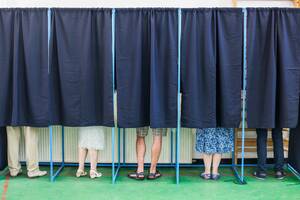The impact of increases in the minimum wage has long caused controversy in political and management circles. Supporters of regular increases argue that those raises are necessary to keep working people from falling below the poverty line. Opponents contend that the increases actually prevent less qualified workers from entering the labor pool because employers can no longer afford to hire them.
Unfortunately, little data existed to support either side, until now. Recently, a Kellogg professor helped to build a model that gives an unexpected answer to the question in one particular type of situation: the service sector that employs minimum-wage workers who depend on incentive payments as part of their earnings, such as servers who receive tips and retail employees and sales staff who work on commission. In these cases, the model strongly suggests that everyone—employers, customers, employees who lose their jobs, and even those who stay—ends up in a worse situation when the minimum wage increases.
“We show the increase will reduce the level of service, hurting customers,” says Jeroen Swinkels, a professor of Management and Strategy at the Kellogg School of Management, who developed the model in collaboration with Ohad Kadan, an associate professor at Washington University, St. Louis. “You end up with a smaller number of workers, and even those workers who keep their jobs are less happy, because they’re forced to work harder for less attractive incentive pay. The surprise is that it’s a lose-lose-lose situation—even for people who keep their jobs.”
Swinkels is quick to point out that the result is not an excuse to ignore the plight of the working poor, but that raising the minimum wage may not be the best way to affect change. Swinkels suggests that individual incomes can be lifted by helping workers find new, higher paying jobs, not by legislating higher pay. There are several ways to accomplish this, he says, from improving employer demand, to creating job-training programs, to improving labor market mobility. All help workers advance while insulating them from adverse market changes. As workers climb the ladder, Swinkels’ model shows their movements can also help the well-being of those who remain in their current jobs.
Unanswered Questions
Swinkels developed the model intending to answer a few longstanding questions: How does a firm choose to change incentives in response to a change in the minimum wage? Do the resultant incentives lead workers to work harder than before? What happens to employment? And are workers, even if they keep their job, better off? “The power of the model,” Swinkels says, “is in the way it tells how it’s going to come out in the wash.”
Swinkels and Kadan base their model on the so-called “moral hazard issue,” which itself stems from the “principal-agent problem.” This deals with situations in which the worker who undertakes specific actions—such as selling items in a department store or serving customers in a restaurant—has incentives that are different from those of the employer. In addition, what the worker does is not directly observable. “As an employer, I can’t see whether you work hard as a salesperson,” Swinkels explains. “I can see the sales you make, but I can’t directly observe whether you are doing the right things at the right moments. So the problem is one of how to provide incentives in this world.”
The new model emerged as part of a project to understand incentive pay in the context of a lower limit on what an employer can pay. “We haven’t had a good model for thinking about this before,” Swinkels says. “The standard model doesn’t allow the latitude to answer the question of how many workers the employer should spread the work among.”
To expand on the standard model, the two theorists relied on a couple of technical advances and a different mathematical approach. They also included recognition of the risks that employees experience when they operate in an environment of high incentives, such as working very hard for a sale that can’t be made for various reasons unrelated to the employee’s effort and ability. “The model incorporates thinking through what these contacts look like in the case of the minimum wage, or limited liability, or legal constraints,” Swinkels notes. “Finally, the model incorporates the ability of the firm to decide not only how hard individuals are working, but also to adjust the number of employees.”
That factor recognizes that employers have some flexibility in the face of an increase in the minimum wage. While the increase inevitably causes employees’ total effort to fall, because the minimized cost of the effort rises with the minimum wage, employers can deal with that decrease in effort in more than one way. For example, they can fire some workers and require everyone who remains to work harder. Or, they can continue to employ all their workers but, in order to maintain minimum overall costs, reduce (costly) incentives for extra effort—in effect, asking the employees to put forth a little less effort. Whichever path they choose, the employers have one end in mind. “It does not matter whether the word processing pool of a firm is typing up the notes of auto body claims adjusters or medical researchers,” Swinkels and Kadan write. “The right thing to do is to minimize the cost per page typed accurately.”
A Series of Trade-offs
For many positions, such as rental car clerks or restaurant servers, firms face the issue of finding enough qualified employees for the total pay package of wages and incentive pay that they offer. Raising the minimum wage would make it a little easier for those firms to recruit the right people. But then, Swinkels and Kadan observe, the firms would reshuffle their incentive pay because they are no longer as worried about recruitment.
This is just one of the possible outcomes of the new model. Overall, Swinkels continues, “We show increases in the minimum wage will reduce the level of service, hurting customers. The surprise is that you end up with a smaller number of workers, and even those workers who keep their jobs are less happy, because they’re forced to work harder for lower incentives. Once the firm has adjusted the number of workers and the market in which it operates has balanced, you end up with harder working, more miserable workers.”
Swinkels emphasizes that the model’s results have implications beyond service area firms and their employees. “Many of these factors will apply to relationships between a firm and its suppliers, involving penalties for suppliers’ poor performance,” he explains. “It can also apply to boards of directors’ treatment of CEOs. And the same piece of mathematics says how a firm will adjust when its employees have more attractive outside options.”
So far, the model remains a theoretical pursuit. “It screams for empirical testing,” Swinkels says. “We hope that it will excite empirical activity by people better qualified at that than ourselves.” Nevertheless, he continues, the project carries a strong message. “The implication is that if you want to help the working poor, this is not the way. There are smarter ways of doing so than by raising wages in the service sector.”
Ohad Kadan and Jeroen Swinkels. 2010. Minimum Payments, Incentives, and Markets. Working paper, Kellogg School of Management.


